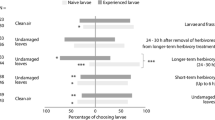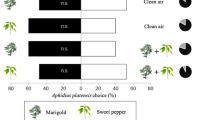Abstract
Herbivore-induced plant volatiles (HIPVs) have been opined as ‘indirect or direct defenses’ of plants and are extensively studied. In contrast, HIPVs may also indicate that plant defenses have been overcome by herbivores infesting the plant; however, studies on this aspect have so far received little attention. Using the interaction of Capsicum annum (Bell pepper) with its pest Scirtothrips dorsalis (Chilli thrips) as a model system, we studied the role of HIPVs in this selected insect–plant interaction. Multiple-choice olfactometer assays with headspace volatiles collected from different growth stages of un-infested C. annum plants represented by pre-flowering (PF), flowering (FL) and fruiting stages (FR) proved FR volatiles to be highly attractive to S. dorsalis. Further, FR plants were infested with S. dorsalis adults and HIPVs released by infested plants were collected and subjected to multiple-choice olfactometer bioassays. Thrips were significantly attracted to HIPVs than to headspace volatiles of un-infested FR plants or thrips body odour. Coupled GC-EAG with S. dorsalis and HIPVs or FR plant volatile revealed specific compounds that elicited an EAG response. Individual EAG-active compounds were less attractive to thrips, however, synthetic blends of EAG-active compounds at the ratio similar to headspace samples were found to be highly attractive. However, when given a choice between synthetic blends of HIPVs and FR, thrips were significantly attracted to synthetic blend of HIPVs. Our study provides empirical data on signals HIPVs may provide to conspecific herbivores and suggests that the role of HIPVs, mostly generalized as defense, may vary based on the interaction and must be studied closely to understand their ecological functions.




Similar content being viewed by others
References
Ananthakrishnan T (1993) Bionomics of thrips. Annu Rev Entomol 38:71–92
Arimura G, Matsui K, Takabayashi J (2009) Chemical and molecular ecology of herbivore-induced plant volatiles: proximate factors and their ultimate functions. Plant Cell Physiol 50(5):911–923
Bernasconi ML, Turlings TCJ, Ambrosetti L, Bassetti P, Dorn S (1998) Herbivore induced emissions of maize volatiles repel the corn leaf aphid Rhopalosiphum maidis. Entomol Exp Appl 87:133–142
Bernays EA, Chapman RF (1994) Host-plant selection by phytophagous insects. Chapman and Hall, New York, pp 1–312
Bolter CJ, Dicke M, Van Loon JJA, Visser JH, Posthumus MA (1997) Attraction of Colorado potato beetle to herbivore-damaged plants during herbivory and after its termination. J Chem Ecol 23:1003–1023
Bruce TJA, Pickett JA (2011) Perception of plant volatile blends by herbivorous insects-finding the right mix. Phytochem 72:1605–1611
Bruce TJA, Wadhams LJ, Woodcock CM (2005) Insect host location: a volatile situation. Trends Plant Sci 10:269–274
Cardoza YJ, Tumlinson JH (2006) Compatible and incompatible Xanthomonas infections differentially affect herbivore-induced volatile emission by pepper plants. J Chem Ecol 32:1755–1768
Carroll MJ, Schmelz EA, Meagher RL, Teal PEA (2006) Attraction of Spodoptera frugiperda larvae to volatiles from herbivore-damaged maize seedlings. J Chem Ecol 32:1911–1924
Carroll MJ, Schmelz EA, Teal PEA (2008) The attraction of Spodoptera frugiperda neonates to cowpea seedlings is mediated by volatiles induced by conspecific herbivory and the elicitor inceptin. J Chem Ecol 34:291–300
Clavijo McCormick A, Irmisch S, Reinecke A, Boeckler GA, Veit D, Reichelt M, Hansson BS, Gershenzon J, Kollner TG, Unsicker SB (2014) Herbivore-induced volatile emission in black poplar: regulation and role in attracting herbivore enemies. Plant Cell Environ 37(8):1909–1923
Clavijo McCormick A, Reinecke A, Gershenzon J, Unsicker SB (2016) Feeding experience affects the behavioral response of polyphagous gypsy moth caterpillars to herbivore-induced poplar volatiles. J Chem Ecol 42:382–393
D’Auria JC, Pichersky E, Schaub A, Hansel A, Gershenzon J (2007) Characterization of a BAHD acyltransferase responsible for producing the green leaf volatile (Z)-3-hexen-1-yl acetate in Arabidopsis thaliana. Plant J 49:194–207
De Moraes CM, Lewis WJ, Pare PW, Alborn HT, Tumlinson JH (1998) Herbivore infested plants selectively attract parasitoids. Nature 393:570–573
De Moraes CM, Mescheer MC, Tumlinson JH (2001) Caterpillar-induced nocturnal plant volatiles repel nonspecific females. Nature 410:577–580
Delphia CM, Mescher MC, De Moraes CM (2007) Induction of plant volatiles by herbivores with different feeding habits and the effects of induced defenses on host-plant selection by thrips. J Chem Ecol 33:997–1012
Dethier VG (1982) Mechanisms of host plant recognition. Entomol Exp Appl 31:49–56
Dicke J, van Beek TA, Posthumus MA, Ben Dom N, Van Bokhoven H, De Groot AE (1990) Isolation and identification of volatile kairomone that affects acarine predator-prey interactions. Involvement of host plant in its production. J Chem Ecol 16:381–396
Dickens JC (2002) Behavioral responses of larvae of Colorado potato beetle, Leptinotarsa decemlineata (Coleoptera: Chrysomelidae) to host plant volatile blends attractive to adults. Agric Entomol 4:309–314
Gatehouse JA (2002) Plant resistance towards insect herbivores: a dynamic interaction. New Phytol 156(2):145–169
Halitschke R, Schittko U, Pohnert G, Boland W, Baldwin IT (2001) Molecular interactions between the specialist herbivore Manduca sexta (Lepidoptera: Sphingidae) and its natural host, Nicotiana attenuata. III Fatty acid-amino acid conjugates in herbivore oral secretions are necessary and sufficient for herbivore-specific plant responses. Plant Physiol 125:711–717
Harari AR, Yakir DB, Rosen D (1994) Mechanism of aggregation behavior in Maladera matrida Argaman (Coleoptera: Scarabidae). J Chem Ecol 20:361–371
Horiuchi JI, Arimura GI, Ozawa R, Shimoda T, Takabayashi J, Nishioka T (2003) A comparison of the responses of Tetranychus urticae (Acari: Tetranychidae) and Phytoseiulus persimilis (Acari: Phytoseiidae) to volatiles emitted from lima bean leaves with different levels of damage made by T. urticae or Spodoptera exigua (Lepidoptera: Noctuidae). Appl Entomol Zool 38:109–116
Huang CH, Yan FM, Byers JA, Wang RJ, Xu CR (2009) Volatiles induced by the larvae of the Asian corn borer (Ostrinia furnacalis) in maize plants affect behavior of conspecific larvae and female adults. Insect Sci 16:311–320
Jaenike J (1990) Host specialization in phytophagous insects. Annu Rev Ecol Syst 21:243–273
Jan De Kogel W (2001) Preference and performance of western flower thrips. Thrips and tospoviruses: Proceedings of the 7th international symposium on Thysanoptera, pp 181–183
Kalberer NM, Turlings TCJ, Rahier M (2001) Attraction of a leaf beetle (Oreina cacaliae) to damaged host plants. J Chem Ecol 27:647–661
Kamala Jayanthi PD, Woodcock CM, Caulfield J, Birkett MA, Bruce TJA (2012) Isolation and identification of host cues from mango, Mangifera indica that attract gravid female oriental fruit fly, Bactrocera dorsalis. J Chem Ecol 38:361–369
Kamala Jayanthi PD, Kempraj V, Aurade RM, Venkataramanappa RK, Nandagopal B, Verghese A, Bruce TJA (2014) Oviposition site-selection by Bactrocera dorsalis is mediated through an innate recognition template tuned to γ-Octalactone. PLoS ONE 9:1–6
Kessler A, Baldwin IT (2001) Defensive function of herbivore-induced plant volatile emissions in nature. Science 291:2141–2144
Kirk WDJ (1985) Effect of some floral scents on host finding by thrips. J Chem Ecol 11:35–43
Landolt PJ, Tumlinson JH, Alborn DH (1999) Attraction of Colorado potato beetle (Coleoptera: Chrysomelidae) to damaged and chemically induced potato plants. Environ Entomol 28:973–978
Landolt PJ, Brumley JA, Smithhisler CL, Biddick LL, Hofstetter RW (2000) Apple fruit infested with codling moth are more attractive to neonate codling moth larvae and possess increased amounts of (E,E)-alpha-farnesene. J Chem Ecol 26:1685–1699
Loughrin JH, Manukian A, Heath RR, Turlings TCJ, Tumlinson JH (1994) Diurnal cycle of emission of induced volatile terpenoids by herbivore-injured cotton plants. Proc Natl Acad Sci USA 91:11836–11840
Loughrin JH, Potter DA, Kemp TRH (1995) Volatile compounds induced by herbivory act as aggregation kairomones for the Japanese beetle (Popilia japonica Newman). J Chem Ecol 21:1457–1467
Palmer JM, Mound LA (1983) The Scirtothrips species of Australia and New Zealand (Thysonaptera: Thripidae). J Nat Hist 17(4):507–518
Pare PW, Tumlinson JH (1997) Induced synthesis of plant volatiles. Nature 385:30–31
Pettersson J (1970) An aphid sex attractant. Entomol Scand 1:63–73
Pickett JA, Wadhams LJ, Woodcock CM (1998) Insect supersense: mate and host location by insects as model systems for exploiting olfactory interactions. Biochemist 20:8–13
Pow EM, Bennison JA, Birkett MA, Luszniak MJ, Manjunatha M, Pickett JA, Segers IS, Wadhams LJ, Wardlow LR, Woodcock CM (1999) Behavioural responses of western flower thrips (Frankliniella occidentalis) to host plant volatiles. In: Vierbergen G, Tune 1 (eds) Proceedings sixth international symposium on thysanoptera, Akdeniz University, Antalya, Turkey, April 27–May 1, 1988, pp 121–128
Reisenman CE, Riffell JA, Duffy K, Pesque A, Mikles D, Goodwin B (2013) Species-specific effects of herbivory on the oviposition behavior of the moth Manduca sexta. J Chem Ecol 39:76–89
Robert CA, Erb M, Duployer M, Zwahlen C, Doyen GR, Turlings TC (2012) Herbivore-induced plant volatiles mediate host selection by a root herbivore. New Phytol 194(4):1061–1069
Stamps JA, Krishnan VV (2005) Nonintuitive cue use in habitat selection. Ecology 86:2860–2867
Stamps JA, Krishnan VV, Reid ML (2005) Search costs and habitat selection by dispersers. Ecology 86:510–518
Sugimoto K, Matsui K, Iijima Y, Akakabe Y, Muramoto S, Ozawa R, Uefune M, Sasaki R, Alamgir KM, Akitake S, Nobuke T, Galis I, Aoki K, Shibata D, Takabayashi J (2014) Intake and transformation to a glycoside of (Z)-3-hexenol from infested neighbors reveals a mode of plant odor reception and defense. Proc Natl Acad Sci USA 111(19):7144–7149
Thompson JN, Pellmyr O (1991) Evolution of oviposition behaviour and host preferences in Lepidoptera. Annu Rev Entomol 65:65–89
Turlings TCJ, Tumlinson JH, Lewis WJ (1990) Exploitation of herbivore-induced plant odors by host-seeking parasitic wasps. Science 250:1251–1253
Ulland S (2007) Functional characterization of olfactory receptor neurons in the cabbage moth Mammestra brassicae L (Lepidoptera: Noctuidae) Gas chromatography linked to single cell recordings and mass spectrometry Doctoral thesis submitted to Norwegian University of Science and Technology
Unsicker SB, Kunert G, Gershenzon J (2009) Protective perfumes: the role of vegetative volatiles in plant defense against herbivores. Curr Opin Plant Biol 12:479–485
Visser JH (1986) Host odor perception in phytophagous insects. Annu Rev Entomol 31:121–144
Visser JH (1988) Host-plant finding by insects: orientation sensory input and search patterns. J Insect Physiol 34:259–268
War AR, Sharma HC, Paulraj MG, War MY, Ignacimuthu S (2011) Herbivore induced plant volatiles—their role in plant defense for pest management. Plant Signal Behav 6(12):1973–1978
Webster B, Bruce TJA, Hardie J, Pickett JA (2010) Volatiles functioning as host cues in a blend become non-host cues when presented alone to the black bean aphid. Anim Behav 79:451–457
Acknowledgements
This work was supported by Grants from the Indian Council for Agricultural Research [ICAR] through National Fellow Project.
Author information
Authors and Affiliations
Corresponding author
Additional information
Handling Editor: Jarmo Holopainen.
Electronic supplementary material
Below is the link to the electronic supplementary material.
Rights and permissions
About this article
Cite this article
Shivaramu, S., Jayanthi, P.D.K., Kempraj, V. et al. What signals do herbivore-induced plant volatiles provide conspecific herbivores?. Arthropod-Plant Interactions 11, 815–823 (2017). https://doi.org/10.1007/s11829-017-9536-2
Received:
Accepted:
Published:
Issue Date:
DOI: https://doi.org/10.1007/s11829-017-9536-2




